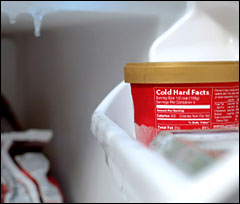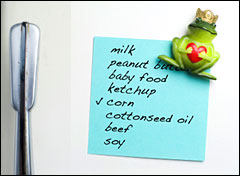
Home is where the fridge is. Whether it’s a top-freezer or side-by-side model, in stainless steel, bisque, or black, that big box in the kitchen is on the job 24-7, rescuing us from hunger, boredom, warm beer, and cravings for Chunky Monkey.
Refrigerators made pre-2000, alas, tend to be major energy hogs that waste watts and money. Add to that the unhealthy, unsustainable stuff so many of us stock inside our refrigerators, and the big box starts looking like an eco-villain.
To start reforming your fridge — and make it earth-friendlier, inside and out — just take a few of the steps that follow. (Check out our handy resources, too.)
Level One: The Baby Steps
Raise the bar. Hey, we said we’d give you easy steps, right? So consider this: Green beer isn’t just for St. Patty’s Day anymore. Stock your fridge year round with eco-conscious cold ones like Fat Tire Ale, made by the Colorado-based New Belgium Brewing Company, which runs on wind power, recycles everything from grain to keg caps, and keeps a sustainability specialist on staff.

How low should you go?
Check out the chill factor. Keep your fridge in the right place: away from the stove or sunny windows. And remember to check its thermostat. Optimum temperatures for victual safety and energy efficiency are between 36 and 38 degrees Fahrenheit for the main compartment and between 0 and 5 degrees Fahrenheit for the freezer. Freezer temps even five degrees colder than that can increase energy consumption by nearly 20 percent.
Level Two: The Next Steps
Don’t eat poison. Buy organic whenever possible. If you do need to buy conventional produce, at least steer clear of the dirty dozen — the fruits and veggies with the heaviest pesticide loads.

Make a not-to-do list.
Photo: iStockphoto
Be unconventional. Keep a list on your fridge of these eight additional troublemakers: conventional versions of milk, peanut butter, baby food, ketchup, corn, cottonseed oil, beef, and soy. Each month, pick one item off the list — corn and its byproducts, for example — and find a way to feast without it. You’ll be reducing your household intake of toxins, pesticides, antibiotics, and hormones. The earth will be happier, too.
Pour yourself some H2 Whoa. There’s oil in them thar plastic water bottles — about 47 million gallons just to produce them for the U.S. market each year. The solution? Wean thyself! Tap water is safer, cleaner, cheaper, and more strictly regulated than the bottled varieties. So drink from the faucet or, for added tastiness and safety, use a water filter, fill up a pitcher, and voilà: you’re good to glug. P.S. Refrigerators with water dispensers use more energy (sigh), but if you’ve got one, make good use of the great filtered H2O it gives.

Level Three: The Big Step
Shop until you drop … kilowatt-hours, that is. Today’s energy-efficient fridges use as little as 250 to 600 kilowatt-hours per year and rack up $50 or less in annual energy bills. By comparison, a typical 1983 brand, according to the nifty Energy Star online calculator, uses 1,500 kilowatt-hours and costs $153 a year. Although they’re worth it over the long haul, new units can cost $500 to $4,500 or more upfront. For that price, make sure to choose a model with the Energy Star label. For added energy savings, go with a top-freezer or bottom-freezer variety, sized 25 cubic feet or less (avoid watt-wasting side-by-side types). And remember to recycle your old monolith: it’s full of refrigerants that definitely aren’t cool.
Craving more information? Check out the links below.
Water and tap water resources:
Natural Resources Defense Council
H2O Conserve
Environmental Working Group Tap Water Quality Database
Water Filter Comparisons
Refrigerator facts and info:
More Energy Savings comparison guide
Consumer Reports-Greener Choices
Green Guide
American Council for an Energy-Efficient Economy
U.S. Energy Star Program
The dirt on problem foods:
Dr. Greene.com
Pesticide Action Network North America
Environmental Working Group
Organic Consumers Association
More green brewers:
Anderson Valley
Sierra Nevada
Full Sail
Fish Brewing Co.
Brooklyn Brewery


